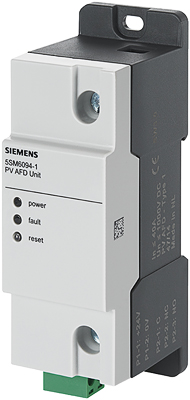New AFDD prevents smoldering fires in PV systems

The new device from the 5SM6 product family detects hazardous arcing faults in the strings of a PV system.
In order to prevent smoldering fires in PV systems, an AFDD permanently measures the intensity and duration of high-frequency noise associated with the voltage and current, as well as noise lapses. Any abnormalities are reported immediately.
Once the cause for an arcing fault has been remedied, the AFDD can then be reset. The arcing fault LED will light up again immediately if the problem was not completely resolved or if other arcing faults are occurring. AFDDs can be surface-mounted or clipped onto a standard mounting rail.
The device is therefore easily integrated in new systems and can be retrofitted in existing systems.
Arcing faults are a particularly high risk in solar power systems: On the one hand, the installations are often subject to extreme environmental conditions, including pressure from snow loads or high winds, which can result in damage to the system.
On the other hand, a solar system represents an increased risk for rescue workers in case of fire when attempting to extinguish the fire with water, if no appropriate disconnecting device is installed with the result that the systems are still supplied with voltage.
For further information on Division Energy Management, please see www.siemens.com/energy-management
For further information on AFDD, please see www.siemens.com/afdd
Siemens AG (Berlin and Munich) is a global technology powerhouse that has stood for engineering excellence, innovation, quality, reliability and internationality for more than 165 years. The company is active in more than 200 countries, focusing on the areas of electrification, automation and digitalization. One of the world's largest producers of energy-efficient, resource-saving technologies, Siemens is No. 1 in offshore wind turbine construction, a leading supplier of combined cycle turbines for power generation, a major provider of power transmission solutions and a pioneer in infrastructure solutions as well as automation, drive and software solutions for industry. The company is also a leading provider of medical imaging equipment – such as computed tomography and magnetic resonance imaging systems – and a leader in laboratory diagnostics as well as clinical IT. In fiscal 2014, which ended on September 30, 2014, Siemens generated revenue from continuing operations of €71.9 billion and net income of €5.5 billion. At the end of September 2014, the company had around 343,000 employees worldwide on a continuing basis.
Further information is available on the Internet at www.siemens.com
Reference Number: PR2015040178EMEN
Contact
Mr. Heiko Jahr
Energy Management Division
Siemens AG
Freyeslebenstr. 1
91058 Erlangen
Germany
Tel: +49 (9131) 7295-75
heiko.jahr@siemens.com
Media Contact
All latest news from the category: Power and Electrical Engineering
This topic covers issues related to energy generation, conversion, transportation and consumption and how the industry is addressing the challenge of energy efficiency in general.
innovations-report provides in-depth and informative reports and articles on subjects ranging from wind energy, fuel cell technology, solar energy, geothermal energy, petroleum, gas, nuclear engineering, alternative energy and energy efficiency to fusion, hydrogen and superconductor technologies.
Newest articles

NASA: Mystery of life’s handedness deepens
The mystery of why life uses molecules with specific orientations has deepened with a NASA-funded discovery that RNA — a key molecule thought to have potentially held the instructions for…

What are the effects of historic lithium mining on water quality?
Study reveals low levels of common contaminants but high levels of other elements in waters associated with an abandoned lithium mine. Lithium ore and mining waste from a historic lithium…

Quantum-inspired design boosts efficiency of heat-to-electricity conversion
Rice engineers take unconventional route to improving thermophotovoltaic systems. Researchers at Rice University have found a new way to improve a key element of thermophotovoltaic (TPV) systems, which convert heat…



